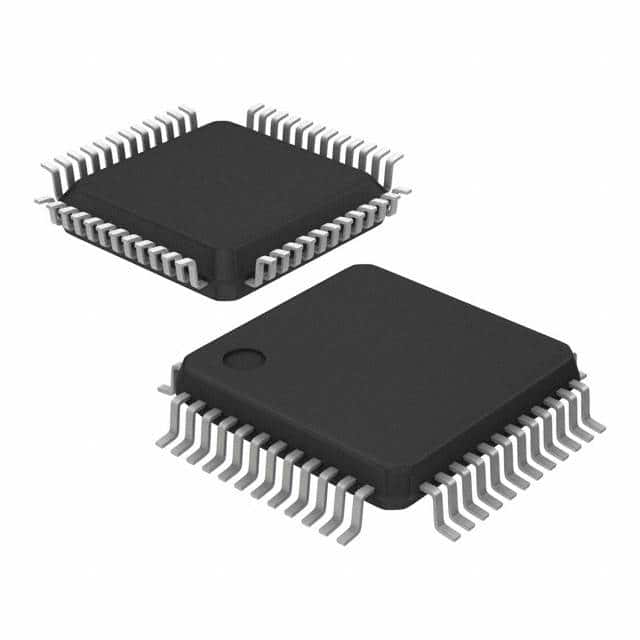Zie specificaties voor productdetails.

MSP430F249TPMR
Product Overview
The MSP430F249TPMR belongs to the category of microcontrollers and is widely used in various embedded systems applications. Known for its low power consumption, high performance, and versatility, this microcontroller comes in a small package and offers a wide range of features suitable for diverse applications.
Basic Information
- Category: Microcontroller
- Use: Embedded systems applications
- Characteristics: Low power consumption, high performance, versatility
- Package: Small form factor
- Essence: Efficient and reliable microcontroller for embedded systems
- Packaging/Quantity: Varies based on supplier and order quantity
Specifications
- Architecture: 16-bit RISC
- CPU Speed: Up to 8 MHz
- Operating Voltage Range: 1.8V to 3.6V
- Digital I/O Pins: 48
- Analog Inputs: 12-bit ADC with multiple channels
- Communication Interfaces: UART, SPI, I2C
- Memory: Up to 60KB Flash, 2KB RAM
Detailed Pin Configuration
The detailed pin configuration of MSP430F249TPMR can be found in the official datasheet provided by the manufacturer.
Functional Features
- Low power consumption modes for battery-operated applications
- Integrated peripherals for versatile connectivity
- High-performance CPU for efficient processing
- Analog-to-digital converter for sensor interfacing
- Flexible communication interfaces for data exchange
Advantages and Disadvantages
Advantages
- Low power consumption extends battery life
- Versatile connectivity options enhance integration with external devices
- High-performance CPU enables efficient processing
- Integrated analog-to-digital converter simplifies sensor interfacing
Disadvantages
- Limited memory compared to some other microcontrollers in the same category
- Higher cost compared to entry-level microcontrollers with similar features
Working Principles
The MSP430F249TPMR operates on the principle of executing instructions stored in its memory to perform specific tasks. It utilizes low power consumption techniques and integrated peripherals to efficiently manage input/output operations and communicate with external devices.
Detailed Application Field Plans
The MSP430F249TPMR is well-suited for a wide range of applications including: - Portable medical devices - Sensor nodes for IoT applications - Battery-powered consumer electronics - Industrial control systems - Smart home automation
Detailed and Complete Alternative Models
- MSP430F248TPMR: Similar features with slightly lower memory capacity
- MSP430F247TPMR: Reduced pin count and memory compared to MSP430F249TPMR
- MSP430F2410TPMR: Higher memory capacity and additional features for more demanding applications
In conclusion, the MSP430F249TPMR microcontroller offers a balance of low power consumption, high performance, and versatile features, making it an ideal choice for various embedded systems applications.
Word Count: 470
Noem 10 veelgestelde vragen en antwoorden met betrekking tot de toepassing van MSP430F249TPMR in technische oplossingen
What is the MSP430F249TPMR microcontroller used for?
- The MSP430F249TPMR microcontroller is commonly used in low-power and battery-operated applications such as portable medical devices, sensor nodes, and industrial control systems.
What are the key features of the MSP430F249TPMR?
- The MSP430F249TPMR features a 16-bit RISC CPU, ultra-low power consumption, multiple built-in communication interfaces, and analog-to-digital converters.
How can I program the MSP430F249TPMR microcontroller?
- The MSP430F249TPMR can be programmed using various integrated development environments (IDEs) such as Code Composer Studio and Energia, as well as through the use of programming tools like JTAG and Spy-Bi-Wire interfaces.
What are the available communication interfaces on the MSP430F249TPMR?
- The MSP430F249TPMR supports communication interfaces such as UART, SPI, I2C, and USB, making it suitable for a wide range of connectivity requirements.
Can the MSP430F249TPMR operate on battery power?
- Yes, the MSP430F249TPMR is designed for ultra-low power operation and can efficiently run on battery power, making it ideal for energy-efficient applications.
What are the analog capabilities of the MSP430F249TPMR?
- The MSP430F249TPMR includes integrated analog-to-digital converters (ADCs) and digital-to-analog converters (DACs), enabling it to interface with analog sensors and actuators.
Is the MSP430F249TPMR suitable for real-time applications?
- Yes, the MSP430F249TPMR's architecture and peripherals make it well-suited for real-time applications, including control systems and data acquisition.
What are the available memory options on the MSP430F249TPMR?
- The MSP430F249TPMR offers flash memory for program storage, as well as RAM for data storage, providing flexibility for various application requirements.
Can the MSP430F249TPMR be used in harsh environmental conditions?
- The MSP430F249TPMR is designed to operate reliably in industrial environments and can withstand a wide temperature range, making it suitable for rugged applications.
Are there any development kits available for the MSP430F249TPMR?
- Yes, Texas Instruments offers development kits and evaluation modules for the MSP430F249TPMR, providing a convenient platform for prototyping and testing technical solutions.

